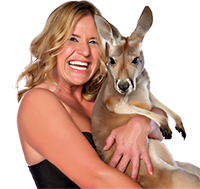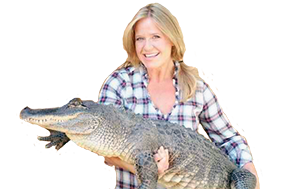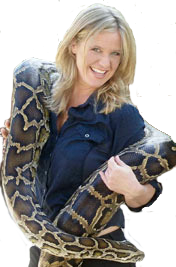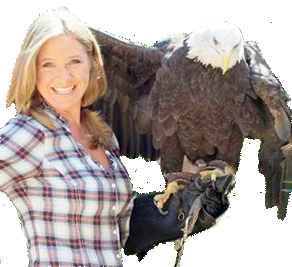 | Kangaroo LanieAmerica's Wild Girl | 
|
..And Her Animal Friends Seen at Events Nationwide | ||
|
| 

|
I offer many canine training services. Please call for your specific need.


Porcupines are rodents with a coat of sharp spines, or quills, that defend and camouflage them from predators. They are indigenous to the Americas, southern Asia, and Africa. Porcupines are the third largest of the rodents, behind the capybara and the beaver. Most porcupines are about 25-36 in (63-91 cm) long, with an 8-10 in (20-25 cm) long tail. Weighing between 12-35 lb (5.4-16 kg), they are rounded, large and slow. Porcupines come in various shades of brown, grey, and the unusual white. Porcupines' spiny protection resembles that of the unrelated erinaceomorph hedgehogs and monotreme echidnas.
The common porcupine is an herbivore. It eats leaves, herbs, twigs and green plants like skunk cabbage and clover and in the winter it may eat bark. The North American porcupine often climbs trees to find food. The African porcupine is not a climber and forages on the ground. [1] It is mostly nocturnal, but will sometimes forage for food in the day. Porcupines have become a pest in Kenya and are eaten as a delicacy.
Porcupines' quills, or spines, take on various forms, depending on the species, but all are modified hairs coated with thick plates of keratin, and they are embedded in the skin musculature. Old World porcupines (Hystricidae) have quills embedded in clusters, whereas in New World porcupines (Erethizontidae), single quills are interspersed with bristles, underfur and hair.
Quills are released by contact with them, or they may drop out when the porcupine shakes its body, but cannot be projected at attackers. New quills grow to replace lost ones. From ancient times, it was believed that porcupines could throw their quills at an enemy, but this has long been refuted.
Porcupines occupy a short range of habitats in tropical and temperate parts of Asia, Southern Europe, Africa, and North and South America. Porcupines live in forests, deserts, rocky outcrops and hillsides. Some New World porcupines live in trees, but Old World porcupines stay on the rocks. Porcupines can be found on rocky areas up to 3,700 m (12,100 ft) high. Porcupines are generally nocturnal but are occasionally active during daylight.

Often confused with crocodiles, this large reptile is the king of the swampland that dates back 37 million years! The American alligator is found in Florida, Mississippi, Lousiana, and many surrounding southeast States. They were hunted to the brink of extinction in the beginning of the 20th century for their hide. The trade in alligator products such as boots, belts, and handbags was widely popular. Through government protection and assisted breeding programs this scaly American icon was brought back from the threat of extinction and now thrives in the American southeast.
The American Alligator is known for it's powerful crushing jaw strength. They are patient predators that will wait for a convenient meal to present itself in or around the swampland. Alligators will eat whatever is convenient from insects to fish to small and even large mammals such as deer! Most people do not know that alligators can go for months without eating at all!
What is the difference between alligators and crocodiles? My answer - not a whole lot! Both are from the scientific order crocodylia, also referred to as crocodilians. So scientifically speaking all alligators are crocodiles but crocodiles are not alligators! Confused yet? One difference is that alligators have a wide "U"-shaped, rounded snout (like a shovel), whereas crocodiles tend to have longer and more pointed "V"-shaped snouts. There are 23 different species of alligators and crocodiles!
The American Alligator is a very maternal reptile. Females will fiercely protect their nests and young. Alligator moms tend to their babies for the first year of life! Gathering the young in their huge mouthes to move them from watering hole to watering hole.
"Spike" the American Alligator has a rags to riches story. He was an unexpected surprise to armed officers conducting a raid on a drug house in Los Angeles over 15 years ago. The officers busted down the doors throughout the home and swiftly ran out of the house when they stumbled upon a four foot alligator staring up at them from the bathtub! Local animal control agents contact the rescue crew at Zoo to You to come retrieve the alligator from the bathtub. Over the last 15 years "Spike" has grown several feet and now weighs a solid 100 pounds and is still growing!
 | Copyright 2012-2024, Kangaroo Lanie -- All Rights Reserved | 
|
..And Her Animal Friends Seen at Events Nationwide | ||
|
| ||
|
Make sure to visit the Conservation Ambassadors Website. |